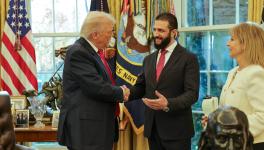Iran’s ‘Look East’ Approach and Potential for India

Chabahar Port is a ‘win-win’ for Iran, India, Afghanistan – and China
The news report in the Tehran Times on Tuesday that Iran and the Russia-led Iran Eurasian Economic Union (EAEU) will set up three more working groups on the expansion of trade ties between the two sides should not come as surprise — except to those Indian analysts who visualise Persian Gulf politics with naïveté as a binary between Shia Iran and Sunni Arab states. The report highlights Iran’s Eurasian integration. What does it entail?
To be sure, Iran-Russia relations are deepening, which would have far-reaching consequences for the geoeconomics of the vast region comprising Eurasia and the Persian Gulf. And it should not go unnoticed in India amidst the shibboleths being propagated by US lobbyists who do not understand Iran.
Iran’s Foreign Minister Javad Zarif was in Moscow on Tuesday on his second visit to Russia in the past two months. The focus is on the JCPOA (2015 nuclear deal) from which the Trump administration unilaterally pulled out two years ago. Washington is now desperately trying to destroy the JCPOA before President Trump’s term in office runs out shortly.
Israel is also frantic since there is great fluidity in US domestic politics and is concerned that the November presidential election may draw the curtains on Trump presidency. A spate of terrorist bombings recently in Iran hints at last-ditch attempts by the US-Israeli intelligence machinery to provoke Tehran into walking out taking some drastic steps that could provide alibi a confrontation before November.
But what complicates matters for the US-Israeli warmongers is that the European Union, as well as UK, France and Germany who are signatories to the JCPOA, refuse to associate with Washington’s game plan to ‘snap back’ the (pre-2015) UN Security Council sanctions against Iran.
Besides, the EU is lately voicing open criticism of the US’ unilateralism and contravention of international law to use sanctions as a geopolitical tool to advance its self-interests. In a statement last Friday, EU foreign policy chief Josep Borrell stated upfront that the US interference in the affairs of Europe through sanctions is unacceptable. Interestingly, Borrell made it a point to disapprovingly cite the US sanctions against Iran as a case in point.
Against such a complex backdrop, Iran’s dependence on Russian support is becoming critical. The three-month period ahead is crucial, as by October, another landmark of the JCPOA will be reached — termination of the UN embargo on Iran’s procurement and sales of weapons. We may anticipate the strengthening of Iran’s military cooperation with Russia (and China).
Now, Iran’s integration into the EAEU comes alongside the $400 billion China-Iran Comprehensive Strategic Partnership agreement, which is under negotiation. What we see here, in sum, is a grand Iranian ‘Look East’ strategy.
From a geoeconomic perspective, while the strategic partnership agreement with China will mark Iran’s surge as a principal template of the Belt and Road Initiative globally, Iran’ integration into the EAEU opens up a free-trade zone with a total population exceeding 260 million.
Iran’s uniqueness as a partner lies in its indigenous capabilities in technology, untapped market (population: 80 million), vast mineral resources including oil and gas (one of the world’s biggest gas reserves, in fact) and its geographical location. None of the other Persian Gulf states can match Iran’s credentials as a regional powerhouse.
Some may have oil, some others gas; but no one can match Iran’s combination of an educated and skilled population, big market, capability in science and advanced technology, strong agricultural base, and massive reserves of diverse minerals ranging from coal to iron ore, Bauxite and aluminium to zinc and lead, uranium to copper, and herbertsmithite to gold.
Unsurprisingly, Iran figures on the European radar as a serious interlocutor. The EU is intensely conscious that the Trump administration’s ‘maximum pressure’ strategy toward Iran has utterly failed to browbeat Tehran into submission. The EU also senses that if Trump fails in his re-election bid, as it seems increasingly, America’s Iran policies will dramatically change course under Joe Biden.
Also watch: Who Benefits From US Escalation Against Huawei?
We may expect Biden to unceremoniously dump his predecessor’s ‘maximum pressure’ approach which is at a dead end, and revive Washington’s participation in the JCPOA, a legacy of the Barack Obama administration.
It is entirely conceivable that harmonising with European allies, Biden Administration will move toward a constructive engagement of Tehran with a view to negotiate a ‘JCPOA+’ — bringing the 2015 nuclear deal within the framework of a broader integration of Iran as a regional power, opening up trade, investment and flow of western technology to Iran.
Of course, this will entail tough negotiations. Iran’s strategic partnerships with Russia and China are symptomatic of an authentic regional power with a world view of its own. Tehran is actively collecting blue chips for the upcoming game of poker with the US.
This is where opportunities lie for Indian diplomacy. India is not in competition with any big power over Iran. Nor is Iran a turf for India’s competition with China. On the contrary, India should emulate Russia, China and the EU — all of whom have successfully diversified their relationships with the regional actors in the Persian Gulf.
Importantly, Indian diplomacy should anticipate the strong likelihood of a shift in the US policies in the Persian Gulf — not only with regard to Iran but also with Saudi Arabia, which has virtually run out of friends on Capitol Hill, Washington’s so-called liberal establishment and the US security establishment.
The US lobbyists in our country are creating confusion by caricaturing the Persian Gulf as a binary between Iran and Saudi Arabia. They are either blissfully unaware of — or are deliberately obfuscating — the undercurrents of regional politics in the Muslim Middle East today.
In the Northern tier of West Asia politics, a regional rivalry that has been simmering in the recent decade has erupted with a demonic fury — arraying Turkey and Qatar on one side and Saudi Arabia, the UAE and Egypt on the other side.
Unlike the Saudi-Iranian rivalry, which is more of a vanity fair, the Saudi-Emirati-Egyptian struggle against Turkey and Qatar has existential overtones, given the spectre of the Muslim Brotherhood that haunts the region’s authoritarian regimes. This is yet to seep into the Indian media narratives.
Conceivably, we should anticipate a truce in the Persian Gulf, which would allow Saudis and Emiratis to focus single-mindedly on the potential surge of political Islam in a broad swathe of the region stretching east from Libya to Egypt and the Arabian Peninsula. A military confrontation between Turkey and Egypt cannot be ruled out, which would inevitably involve Qatar on Turkey’s side and Saudis and Emiratis on the side of Egypt.
Suffice to say, India is not a one-dimensional city-state like Singapore or Monaco, from where one may get a jaundiced view of West Asian politics. India is West Asia’s next-door neighbour and Persian Gulf politics is felt in our blood and felt along the heart. India doesn’t need US lobbyists to educate it about Iran.
India’s relationship with Iran will survive the canards and disinformation spread by US-Israeli lobbyists to create misperceptions. So long as India preserves its strategic autonomy and pursues independent foreign policies, the bedrock of mutual understanding with Iran will continue to be available for policymakers in Delhi to build on.
In a not-too-distant future, trains will begin to run from India’s Chabahar-Port container terminals to the Afghan border, thanks to the joint efforts of Delhi and Tehran. In fact, in a curious twist of irony, Afghanistan has just dispatched a consignment via Chabahar Port to Kandla — en route to China!
Also read: Central Vista Redevelopment Project: Greening or Greenwashing?
Get the latest reports & analysis with people's perspective on Protests, movements & deep analytical videos, discussions of the current affairs in your Telegram app. Subscribe to NewsClick's Telegram channel & get Real-Time updates on stories, as they get published on our website.






















